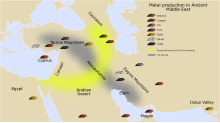

The metals of antiquity are the seven metals which humans had identified and found use for in prehistoric times in Africa, Europe and throughout Asia:[1] gold, silver, copper, tin, lead, iron, and mercury. These seven are the metals from which the classical world was forged.
Zinc, arsenic, and antimony were also known during antiquity, but they were not recognised as distinct metals until later.[2][3][4][5] A special case is platinum; it was known to native South Americans around the time Europe was going through classical antiquity, but was unknown to Europeans until the 18th century. Thus, at most eleven elemental metals and metalloids were known by the end of antiquity; this contrasts greatly with the situation today, with over 90 elemental metals known. Bismuth only began to be recognised as distinct around 1500 by the European and Incan civilisations. The first elemental metal with a clearly identifiable discoverer is cobalt, discovered in 1735 by Georg Brandt, by which time the Scientific Revolution was in full swing.[6] (Even then, cobalt might have been prepared before the 13th century by alchemists roasting and reducing its ore, but in any case its distinct nature was not recognised.)[7]
- ^ Cite error: The named reference
History of Technology, 29was invoked but never defined (see the help page). - ^ Moorey, P. R. S. (1994). Ancient Mesopotamian Materials and Industries: the Archaeological Evidence. New York: Clarendon Press. p. 241. ISBN 978-1-57506-042-2.
- ^ Healy, John F. (1999). Pliny the Elder on Science and Technology. Oxford University Press. ISBN 9780198146872. Retrieved 26 January 2018.
- ^ Holmyard, Eric John (1957). Alchemy. Courier Corporation. ISBN 9780486262987. Retrieved 26 January 2018.
- ^ Biswas, Arun Kumar (1993). "The Primacy of India in Ancient Brass and Zinc Metallurgy" (PDF). Indian Journal of History of Science. 28 (4): 309–330. Retrieved 4 January 2024.
- ^ Miśkowiec, Paweł (2022). "Name game: the naming history of the chemical elements—part 1—from antiquity till the end of 18th century". Foundations of Chemistry. 25: 29–51. doi:10.1007/s10698-022-09448-5.
- ^ Weeks, Mary Elvira (1960). Discovery of the Elements (6th ed.). Journal of Chemical Education. p. 153.
© MMXXIII Rich X Search. We shall prevail. All rights reserved. Rich X Search
